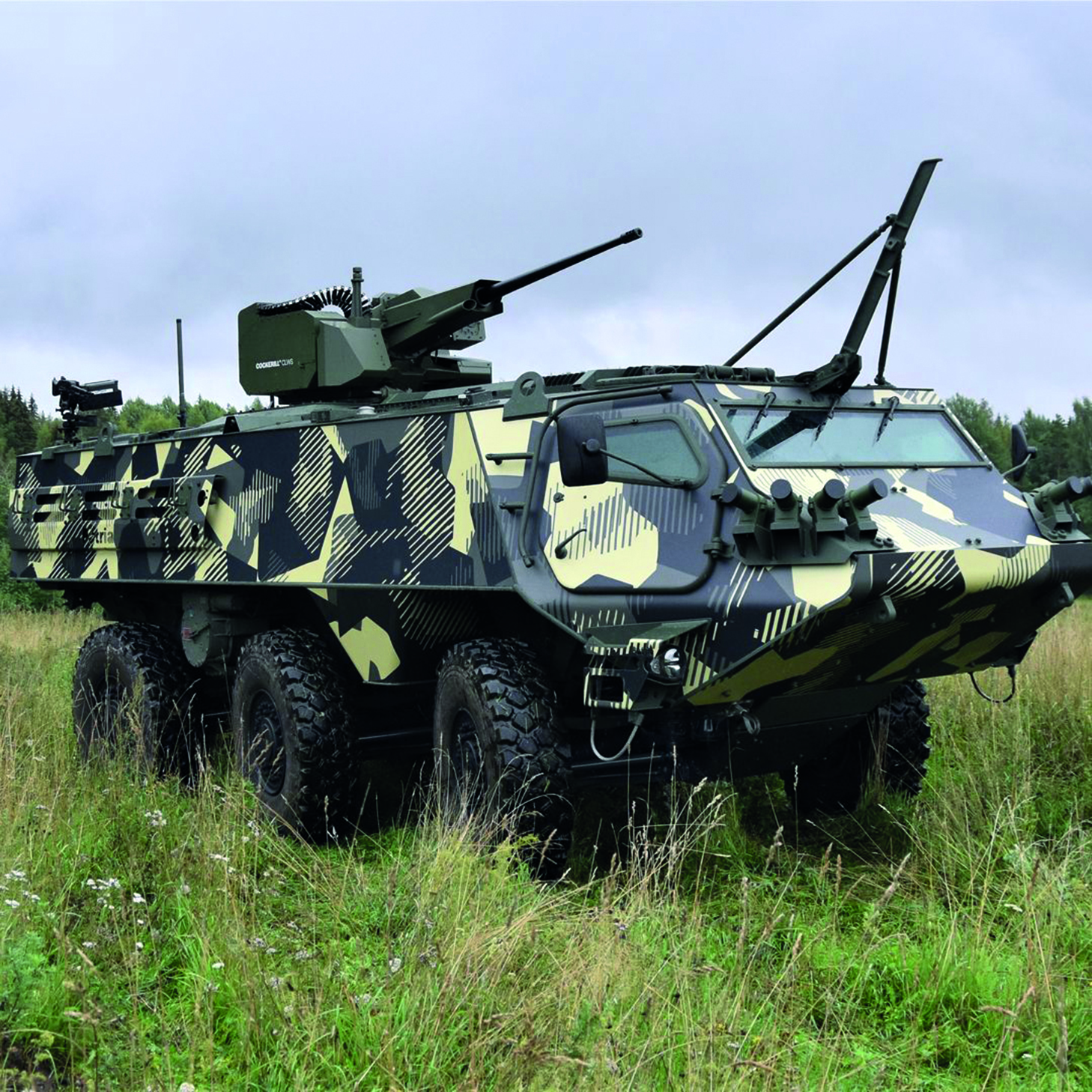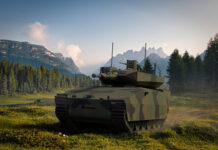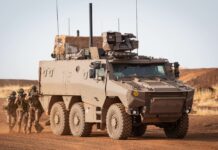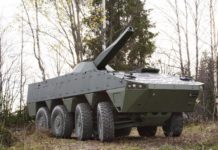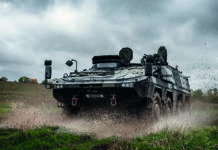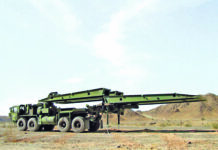While an increasing number of European countries are moving to a more balanced fleet of tracked and wheeled (8×8) medium Armoured Fighting Vehicles (AFV) for use in the Infantry Fighting Vehicle (IFV) and Armoured Personnel Carrier (APC) roles, there is still a place for more compact platforms including 6×6.
In some cases, these have been developed to meet the specific requirements of the home market but in some cases, Original Equipment Manufacturers (OEM) have developed 6×6 platforms specifically for the export market. Austria, Belgium, Finland, Estonia, France, Latvia and Sweden either operate new fleets of 6×6 APC, or are moving in that direction.
The main advantages of these 6×6 APC is that they are more compact and well suited to operations in confined spaces as well as being easier to transport by air.
PANDUR
In addition to a fleet of 112 General Dynamics European Land Systems-Steyr (GDELS) ULAN tracked IFVs, the Austrian Army took delivery of 71 PANDUR (6×6) APC of which three were in the ambulance configuration. Since then, these have been upgraded with an enhanced passive armour package developed by RUAG of Switzerland which has also been fitted to Belgian PANDUR vehicles. Export sales of the PANDUR (6×6) were made to Belgium, Kuwait (first batch from a US production line and second batch from Austrian production line), Slovenia (local production as the VALUK) and the US Amy for the Special Operations Command to meet their requirement for an Armored Ground Mobility System (AGMS). Austrian Army PANDUR (6×6) have a protected weapon station (PWS) normally armed with a 12.7 mm M2 HB machine gun (MG).
PANDUR (6×6) platform can be fitted with much heavier weapons with the ones for Kuwait including a 81 mm mortar carrier, fitted with a two person turret armed with a Northrop Grumman 25 mm M242 dual feed cannon and 7.62 mm co-axial MG with another fitted with a now John Cockerill Defense turret armed with a 90 mm gun and 7.62 mm co-axial MG.
The Austrian Army subsequently took delivery of 34 PANDUR (6×6) Evolution (Evo) and in late 2020 the Austrian MoD ordered another 30 PANDUR (6×6) Evo with deliveries to run from 2022 through to 2024. The latter are in APC configuration but their modular design enables them to be rapidly rerolled for other battlefield missions including casualty evacuation, for example.
When compared to the original PANDUR, PANDUR Evo has improved mobility and protection and when being used as an APC has a crew of three plus eight dismounts.
GDELS – Steyr also developed the PANDUR II (8×8) for the export market with sales to Czech Republic and Portugal and more recently to the Philippines, although the latter contract through Elbit of Israel with the vehicles coming from the Czech Republic. According to GDLES, “more than 800 PANDUR platforms are in operation worldwide of which more than 500 are in NATO”.
The Canadian Army operated 491 now General Dynamics Land Systems – Canada Armoured Vehicle General Purpose (AVGP) but these have been phased out of service as Canada has concentrated on 8×8 platforms as they have more volume and payload.
Patria developed the XA series of 6×6 APC and variants which were built in large numbers for the home and export market with the latter including Lithuania, Netherlands, Norway and Sweden. Estonia has taken delivery of surplus vehicles from Finland and the Netherlands and at least part of the Finnish Defense Force (FDF) are being upgraded to extend their operational lives.
AMV and CAVS
Patria then developed its best-selling Armoured Modular Vehicle (AMV) (8×8) and more recently the AMV XP (8×8) which features extra performance, payload and protection and can have a gross vehicle weight of up to 32 tonnes. Patria saw that there was still a requirement for a new generation 6×6 and in mid-2018 launched their new vehicle which was originally simply called the Patria 6×6 and early in 2020 it was announced that this had been chosen as part of a joint Finnish-Latvian vehicle development programme which is also called the Common Armoured Vehicle System (CAVS). Latvia has already started taking delivery of more than 200 CAVS and Finland has signed a letter of intent to order 160 in 2023. In December 2021 it was announced that Sweden wanted to join CAVS.
Early in 2021, Patria and SIA Unitruck established a joint venture in Latvia called SIA Defence Partnership Latvia which is owned 70% by Patria and 30% by Unitruck. This has a maximum GVW of up to 24 tonnes of which 8.5 tonnes is the payload which comprises the crew, weapons, ammunition and the modular armour package which is to STANAG 4569 Level 2 baseline but upgradeable to Level 4. For improved mobility it has a fully independent suspension system with powered steering on 1st and 2nd axles with option rear axle steering. Options include an amphibious capability and a central tyre inflation system (CTIS).
The Finnish company Protolab Oy has developed a Protected Multi-Purpose Vehicle (PMPV) and under a contract signed in 2018 four have been delivered to the FDF. The latest versions are the PMPV 2 and PMPV 3 with the latter having more powerful engine options.
VBCI and VAB
Apart from its Nexter LECLERC Main Battle Tanks (MBT) and some remaining AMX-30 series specialised support vehicles, the French Army has moved to a total wheeled fleet of AFVs which offer greater strategic mobility over their tracked counterparts, this is of particular value to France with its remaining interests in Africa. The French Army has replaced its tracked AMX-10P IFV with 630 Vehicule Blindé de Combat d’Infanterie (VBCI) (8×8) in IFV and command post versions.
Arquus (previously Renault Trucks Defense) built over 5,000 of its Vehicule de Avant Blindé (VAB) APC plus a huge number of more specialised versions for the home and export market. The French Army only took delivery of 3,975 of the 4×4 model from 1976 but export sales were made of the 6×6 model with its greater mobility. For operations overseas part of the French Army VAB fleet has been upgraded which included increased protection, electronic devices to counter improvised explosive devices (IED), Kongsberg RWS and acoustic detection devices to name but a few.
GRIFFON
The VAB has now started to be replaced by the GRIFFON (6×6) APC which is manufactured at the Nexter facility in Roanne with Arquus supplying the complete drive line and Thales the electronics and optronics. Late in December 2021 it was announced by the industrial consortium that a total of 339 GRIFFON (6×6) had been delivered to the French Army. All variants of the APC version have now been qualified with the ambulance and artillery observation versions due to be qualified in 2022. The French Army is expected to take delivery of 1,722 GRIFFON while Belgium will take delivery of 417 GRIFFON.
While the VAB (6×6) had a typical GVW of only 12.7 tonnes when it was first deployed the GRIFFON (6×6) has a GVW up to 24.50 tonnes due to its greater volume, payload and protection. The baseline GRIFFON (6×6) APC has a crew of three and carries eight dismounts but a number of more specialised versions have already been developed including a command post and a version with a Thales 120 mm 2R2M mortar in the rear firing through open roof hatches.
The GRIFFON (6×6) is one part of a complete series of new wheeled vehicles being deployed by the French Army with the other two being the JAGUAR (6×6) reconnaissance vehicle (also ordered by Belgium) and the SERVAL (4×4) APC plus many variants. While Arquus Defense is involved in the GRIFFON (6×6) using internal research and development funding it has developed the VAB Mk 3 for the export which is marketed only in a 6×6 configurations with a typical GVW of up 20 tonnes of which 7.5 tonnes is payload. This can be fitted with a wide range of weapon stations up to a John Cockerill Defense two person turret armed with a 90 mm gun and 7.62 mm co-axial MG. This has been sold to Tunisia from the Mack production line in the USA and called Lakota) and the Kingdom of Saudi Arabia (fitted with a Nexter ARX25 RCT armed with 25 mm cannon and 7.62 mm coaxial MG) plus at least one other country.
TITUS
Nexter has a long tradition of investing its own research and development funding in new products for both the home and export markets. A good example is their Tactical Infantry Transport & Utility Sysyem (TITUS) (6×6) which was first unveiled in late 2013 with the first export customer being the Czech Republic who have ordered 62 units for specialised battlefield missions (command, signals, artillery fire coordination) rather than being used in the APC mission. TITAS is based on a TATRA (6×6) chassis which gives a high level of cross country mobility with the all welded steel hull with applique armour giving a high level of ballistic, mine and IED protection.
FUCHS
The German Army took delivery from the now Rheinmetall MAN Military Vehicles (RMMV) of 996 FUCHS (6×6) APC and variants with final deliveries taking place in 1986, but production continued for the export market. A FUCHS (8×8) was built and tested by this never entered production.
The German Army still has a significant fleet of FUCHS (6×6) with the latest upgraded version being the FUCHS 1A8 which has a higher level of mine and ballistic protection as well as de-coupled seating, reinforced wheel housings, doors and window mountings to name but a few. Further development has resulted in the FUCHS 1A8 Plus which has a new power pack, transfer case, improved steering and cameras for situational awareness. For the export market, RMMV developed the FUCHS 2 (6×6) which has more volume and payload and has a typical GVW of at least 23 tonnes of which payload is 6 tonnes. Over 1,000 have been sold including Algeria (local production), Kuwait and the United Arab Emirates (UAE) who took delivery of a fleet of 32 in the highly specialised NBC reconnaissance role.
PIRANHA and DRAGÓN
The Spanish Army operates a large fleet of now BMR-600 (6×6) APC and variants but these will be replaced by a new vehicle called DRAGÓN based on the Swiss PIRANHA V (8×8) with final assembly and integration being undertaken by GDELS-Santa Barbara Sistemas. First contract is for 348 but up to 1,000 is the long term aim.
Turkish Platforms
Turkey has traditionally relied on medium tracked IFVs and APCs but the Turkish defence industry has been very successful in exporting 4×4, 6×6 and 8×8 wheeled AFVs. A typical example is the FNSS Savunma Sistemleri PARS FOV which was originally marketing in 4×4, 6×6 an 8×8 models but sales are now concentred on the latter two. Whilst Malaysia opted for the PARS (8×8) and took delivery of a total of 257 in 12 configurations Oman opted for a mixed fleet consisting of 145 8×8 and 27 in 6×6 configuration under the designation of PARS II with some 80 fitted with the latest SABER 25 mm turret.
In 2019, Turkey ordered 100 PARS III of which 55 are in 8×8 configuration and 45 in 6×6 configuration, with deliveries underway including some 6×6 for the Special Forces. Otokar are the largest manufacturer of wheeled AFVs in Turkey with their COBRA (4×4) being built in large numbers for the home and export markets.
To meet user requirements for wheeled vehicles with more volume, payload and protection Otokar developed the ARMA FOV which are available in 8×8 and 6×6 versions and share many common components. The ARMA (8×8) has a typical GVW of up to 25 tonnes of which 19 tonnes in payload and can be fitted with a wide range of weapons up to a turret armed with a 105 mm gun and 7.62 mm MG. Otokar have confirmed that the ARMA 6×6 is in service with Turkey who has also ordered the ARMA 8×8. The ARMA 6X6 is in service with Bahrain while an African country has ordered ARMA 8×8 and further development of this resulted in the deployed by the United Arab Emirates as the RABDAN. The third company to design a 6×6 APC was Nurol Makina who developed the EJDER (6×6) APC with 70 being delivered to Georgia from 2007. All marketing of this has now ceased as the company is concentrating on its 4×4 series of APCs and variants.
Kazakhstan Paramount Engineering has been building the South African Paramount MATADOR (4×4) MARAUDER (4×4) mine protected vehicles (MPV) and late in 2021 it was announced that production of the BARYS (6×6) has started in Kazakhstan. The BARYS is a further development of the MBOMBE (6×6) optimised to meet specific local requirements. Iveco Defence Systems has developed a 6×6 APC which is now in quantity production in Brazil.


